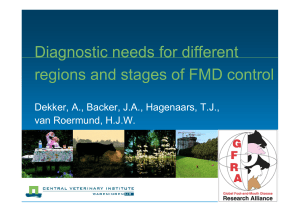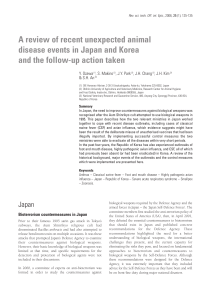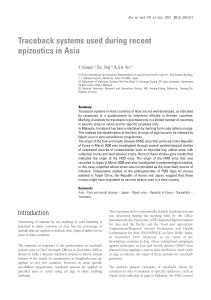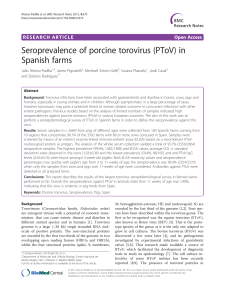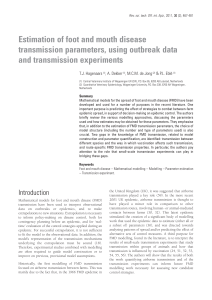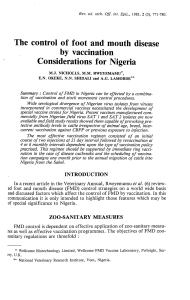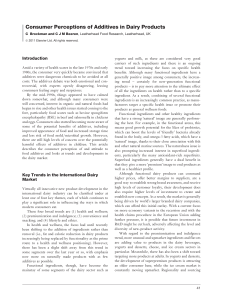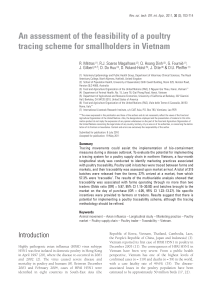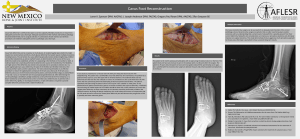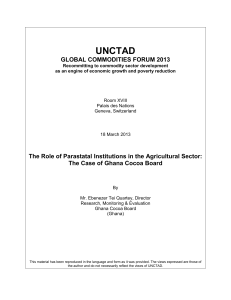D8753.PDF
publicité
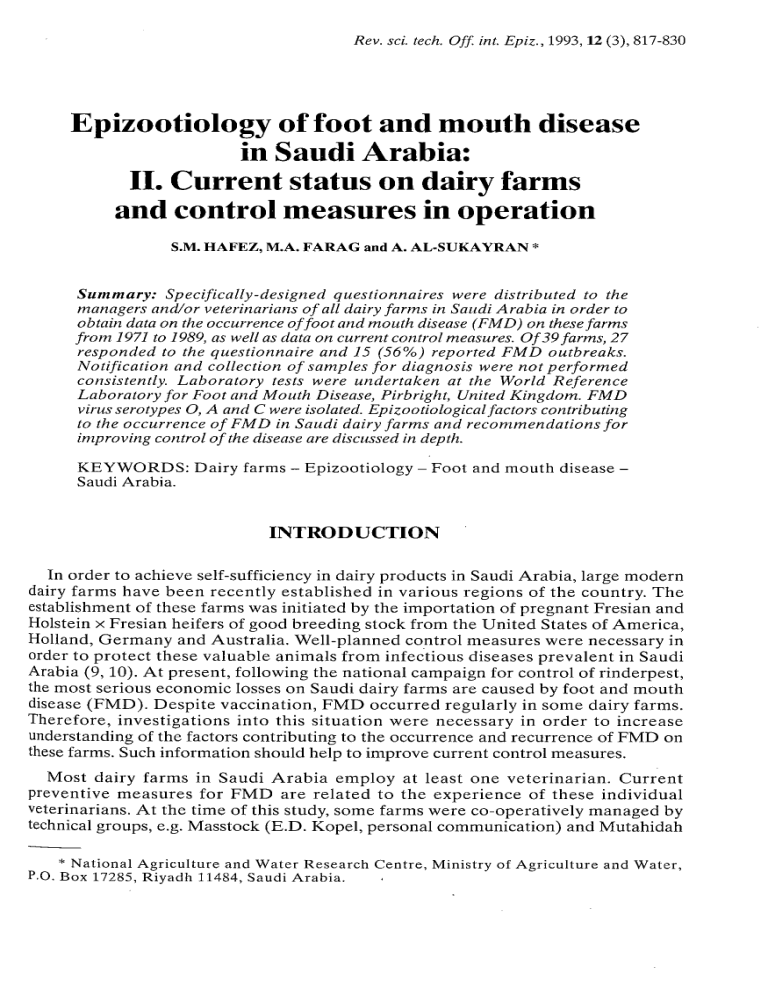
Rev. sci. tech. Off. int. Epiz., 1993, 12 (3), 817-830 Epizootiology of foot and mouth disease in Saudi Arabia: II. Current status on dairy farms and control measures in operation S.M. HAFEZ, M.A. FARAG and A. AL-SUKAYRAN * Summary: Specifically-designed questionnaires were distributed to the managers and/or veterinarians of all dairy farms in Saudi Arabia in order to obtain data on the occurrence of foot and mouth disease (FMD) on these farms from 1971 to 1989, as well as data on current control measures. Of 39 farms, 27 responded to the questionnaire and 15 (56%) reported FMD outbreaks. Notification and collection of samples for diagnosis were not performed consistently. Laboratory tests were undertaken at the World Reference Laboratory for Foot and Mouth Disease, Pirbright, United Kingdom. FMD virus serotypes O, A and C were isolated. Epizootiological factors contributing to the occurrence of FMD in Saudi dairy farms and recommendations for improving control of the disease are discussed in depth. K E Y W O R D S : Dairy farms - Epizootiology - Foot and mouth disease Saudi Arabia. INTRODUCTION In order to achieve self-sufficiency in dairy products in Saudi Arabia, large modern dairy farms have b e e n recently established in various regions of the country. T h e establishment of these farms was initiated by the importation of pregnant Fresian and Holstein x Fresian heifers of good breeding stock from the United States of America, Holland, G e r m a n y and Australia. Well-planned control measures were necessary in order to protect these valuable animals from infectious diseases prevalent in Saudi Arabia (9, 10). At present, following the national campaign for control of rinderpest, the most serious economic losses on Saudi dairy farms are caused by foot and mouth disease ( F M D ) . Despite vaccination, F M D occurred regularly in some dairy farms. Therefore, investigations into this situation w e r e necessary in o r d e r to increase understanding of the factors contributing to the occurrence and recurrence of F M D on these farms. Such information should help to improve current control measures. Most dairy farms in Saudi A r a b i a employ at least one v e t e r i n a r i a n . C u r r e n t preventive m e a s u r e s for F M D are r e l a t e d to t h e experience of these individual veterinarians. A t the time of this study, some farms were co-operatively managed by technical groups, e.g. Masstock (E.D. Kopel, personal communication) and Mutahidah * National Agriculture and Water Research Centre, Ministry of Agriculture and Water, P.O. Box 17285, Riyadh 11484, Saudi A r a b i a . 818 (S. Al-Yahya, personal communication). These groups are based in Riyadh and have specialists in various fields of animal health and production who pay regular visits to the farms for routine m a n a g e m e n t and the solving of any problems which arise. These technical groups are trying to unify and standardise the disease control programmes applied on the various farms which they manage (4). The purpose of this study was to analyse the epizootiological aspects of F M D on Saudi dairy farms, with special emphasis on current control measures and the likely factors which contribute to the recurrence of the disease on some farms. HISTORY OF FOOT A N D MOUTH DISEASE IN S A U D I D A I R Y F A R M S D a t a on the occurrence of F M D in the past were collected by distributing a specifically-designed questionnaire to all dairy farms in Saudi A r a b i a (Fig. 1). The questionnaires were distributed in August 1989 through the Director General of the National Agriculture and Water Research Centre. Of the 39 farms which received the questionnaire, 27 (69%) responded. Between 1971 and 1989, 37 o u t b r e a k s of F M D occurred in 15 (56%) of the 27 farms which responded to the questionnaire (Table I). The occurrence of F M D was reported once on five (33%) farms, twice on four (27%) farms, three times on three (20%) farms, four times on two (13%) farms and seven times on one (7%) farm. Samples for l a b o r a t o r y diagnosis were collected from all F M D outbreaks on nine (60%) of the farms, and from some but not all the outbreaks on three (20%) of the farms; no samples were collected from the F M D outbreaks on the other three farms (Table I). Testing of samples was conducted at the Office International des Epizooties (OIE)/Food and Agriculture Organisation of the United Nations (FAO) World Reference L a b o r a t o r y ( W R L ) for F M D in Pirbright, U n i t e d Kingdom. The results revealed the involvement of F M D virus serotypes O, A and C. Serotype O was the most prevalent, while serotype C was isolated from two farms in 1984 and serotype A was isolated from two farms in 1986 and 1987 (Table I). A d d i t i o n a l data were also collected from the records of t h e W R L . T h e s e data indicated the isolation of serotypes O and C from samples collected in 1983 and 1984 from two of the twelve farms which did not respond to the questionnaire. The location of farms in which F M D outbreaks were reported is shown in Figure 1. CURRENT FOOT A N D MOUTH DISEASE CONTROL PROGRAMMES Most Saudi dairy farms are considering the application of animal health measures and immunoprophylaxis to control both the F M D viruses prevalent in the Saudi environment and those which could be introduced through live animal importation from enzootic countries. However, the efficacy of such measures is inconsistent. The methods currently undertaken are detailed below. Structural measures Most of the farms have fences to prevent free admission to the area of the farm, and all farms have baths in front of the entrance gates for the disinfection of vehicle wheels. 819 • Farms which responded to the questionnaire and in which foot and mouth disease (FMD) outbreak(s) had occurred O F a r m s which r e s p o n d e d to the q u e s t i o n n a i r e and had n o history of p r e v i o u s occurrence of F M D • Farms which did not respond to the questionnaire, but in which previous occurrence of F M D was previously confirmed by the O I E / F A O World Reference Laboratory for F M D • Farms which did not respond to the F M D questionnaire FIG. 1 Map of Saudi Arabia showing the location of dairy farms Functional measures Dairy animals are imported from FMD-free countries. They are transported by air to Saudi A r a b i a in o r d e r to avoid contact in Saudi s e a p o r t s with slaughter animals imported from countries enzootic for F M D and other tropical diseases. All imported animals are vaccinated upon arrival against diseases enzootic in Saudi Arabia, including F M D . T h e vaccination p r o g r a m m e is applied according to the instructions of the vaccine m a n u f a c t u r e r or on the basis of the experience of the veterinarian(s) on the farm. Some farms submit, to the vaccine p r o d u c e r s , serum samples from vaccinated animals collected at various times post-vaccination in order to evaluate vaccine efficacy. 820 TABLE I Data obtained from Saudi dairy farms in response to a questionnaire occurrence of foot and mouth disease (FMD) Location Total no. of animals Year of FMD occurrence Laboratory diagnosis (Y=Yes; N=No) regarding FMD serotype Farms managed by the Masstock Technical Group 1986 2,520 Durma 1988 1983 Near Kharj 2,027 1988 1985 3,105 Tawdihia 1988 1988 Near Kharj 2,024 Y Y Y Y N Y Y A O O O Farms managed by the Mutahidah Technical Group 1983 Near Kharj 2,876 1985 1987 Near Kharj 3,482 1984 1986 1987 Haradh 5,316 1987 N N N Y Y Y Y - Farms managed individually Hofuf 260 Near Kharj 1,424 Near Kharj Kharj Near Kharj Near Kharj Najran 16,434 891 1,008 3,747 516 Experimental university farm Riyadh 215 1971 1983 1985 1988 1982 1983 1984 1984 1986 1987 1989 1982 1983 1983 1983 1986 1987 1989 1987 Y Y Y Y Y Y Y Y Y Y Y N N Y Y N Y Y N 1983 1985 1986 1988 N N Y N - o o c oA O o o o o o o o c oA O - _ o o - not typed O — — A - 821 Some farms produce green fodder on site in order to avoid the purchase of possibly contaminated fodder. If F M D is suspected, the following measures are implemented by some farms (e.g. farms belonging to the Masstock Group): - isolating the affected animals and placing the entire farm under quarantine - notifying the official veterinary authority of the Ministry of Agriculture - collecting samples for laboratory diagnosis and data for epizootiological analysis - immediately revaccinating the entire herd against F M D - banning all movement of vehicles, equipment and personnel to or between any dairy farms unless specifically authorised - requiring any p e r s o n leaving t h e farm to have a shower and change working clothes and footwear for freshly laundered clothes and other footwear which must be disinfected before leaving the farm - systematically treating affected animals - disinfecting all authorised vehicles travelling to or from the farm. If F M D is notified, the Veterinary Authorities of the Ministry of Agriculture co­ operate with the staff of the affected farm in controlling the disease. In such a case, the Veterinary Authority distributes an official circular to other dairy farms and district field veterinarians informing t h e m with regard to the clinical status of F M D in t h e various regions of the country. POSSIBLE FACTORS CONTRIBUTING T O T H E O C C U R R E N C E OF FOOT A N D MOUTH DISEASE The occurrence of F M D outbreaks on dairy farms would indicate one or both of the following: - the introduction of F M D virus onto the farm, or the excretion of F M D virus by carrier animals present on the farm - the presence of non- or partially-immune animals on the farm. When attempting to specify the factors contributing to the occurrence of F M D on Saudi dairy farms under current field conditions in the country, it is important to analyse the possible factors leading to the two major conditions mentioned above. POSSIBLE FACTORS CONTRIBUTING T O T H E TRANSMISSION AND/OR PERSISTENCE OF FOOT A N D MOUTH DISEASE VIRUS FMD virus could be introduced onto the dairy farms via the following routes: a) the green fodder supply b) vehicles used for transporting milk or animals 822 c) farm workers, particularly those working on more than one farm d) visitors to the farm or merchants buying young calves from the farm e) the presence of sheep or other range animals on the dairy farm f) grazing of range animals not belonging to the farm (sheep, goats or camels) on the green fodder fields g) location of the farm on a main road leading to other dairy farms or along which there is continuous movement of animals h) airborne transmission of the virus over relatively long distances (6, 8) i) passive transmission of FMD virus by birds, rodents, dogs or insects (14). The presence of one or more of these factors was reported by all the farms on which F M D occurred. Comparison with other dairy farms which had no previous history of FMD showed that the factors associated with F M D transmission to Saudi farms were numerous and complex (Table II). Nevertheless, it is clear that the Saudi dairy farms are not absolutely isolated from the environment in which F M D virus may be circulating, and there is continuous risk of exposure to infectious sources. Preliminary data have indicated the presence of FMD virus carrier animals on some dairy farms with a previous history of F M D outbreaks (11). D u e to the relatively large numbers of animals on dairy farms in Saudi Arabia, further studies are required to investigate the persistence on the farms of carrier strains of F M D virus and the possible role of such strains as a potential source of infection (5, 13). TABLE II Frequency of factors possibly contributing to the transmission of foot and mouth disease (FMD) virus to Saudi dairy farms No. (%) of farms indicating possible contribution Factors Farms with previous FMD history (n = 15) Farms without previous FMD history (n = 12) 10 (67%) 7 (58%) Receiving raw milk from other farms for processing 4 (27%) 1 (8%) Selling milk to other farms 7 (47%) 8 (67%) Exchange of staff with other farms 4 (27%) 8 (67%) Presence of sheep in the dairy farm 2 (13%) 2 (17%) Grazing of range animals (not belonging to the farm) in the green fodder fields of the farm 6 (40%) 9 (75%) Location of the farm on a main road leading to other farms 7 (47%) 4 (33%) Purchase of green fodder from outside the farm 823 POSSIBLE FACTORS LEADING T O VACCINATION FAILURE Morbidity rates during F M D outbreaks on Saudi dairy farms since September 1988 ranged from 3 % to 5 3 % (unpublished findings). Some of these o u t b r e a k s occurred among specific age groups of animals only a few weeks after t h e most r e c e n t F M D vaccination. This vaccination failure might be due to inadequacies in the vaccine itself, the vaccination programme(s) and/or the immune response of vaccinated animals. Vaccine currently used in Saudi Arabia Laboratory diagnosis of F M D outbreaks in Saudi Arabia showed the presence of a variety of virus serotypes ( 2 , 1 1 ) . T h e F M D vaccines e m p l o y e d a r e f o r m u l a t e d to incorporate strains which are antigenically related to the Saudi field isolates. However, the appearance of new F M D viruses which show antigenic differences when compared with the previously-isolated viruses raises the question of the efficacy of the vaccines currently in use. Such was the case with F M D virus serotype A isolated from Saudi Arabia in 1986 (18) and serotype O isolated in 1988 (19). Accordingly, it is important to continuously monitor the antigenic profile of F M D virus strains currently circulating in the field, in order to confirm the likelihood of the vaccine in use providing protection against these isolates. A t present, the Saudi Veterinary Authorities are following the advice of the W R L (where the Saudi isolates of F M D virus are subtyped and compared with the c u r r e n t vaccine strains) r e g a r d i n g any necessity for F M D vaccine reformulation. The vaccine presently in use is quadrivalent, incorporating serotypes O (2 strains), A (2 strains), C and Asia 1. In addition to antigenic specificity, the potency and freedom from residual infectivity of the vaccine should also b e considered. Currently, batches of commercial F M D vaccines are imported but not tested locally for potency and safety. T h e potency of a vaccine would be reduced if the cold chain is not optimally maintained during storage and transportation, or if the vaccine is used after the expiry date. Vaccination programmes Analysis of data obtained through the questionnaire revealed that most of the F M D vaccination programmes applied were not based on clear scientific criteria. A number of programmes are used for the primary vaccination of calves (Table III). The vaccineproducing c o m p a n i e s r e c o m m e n d that calves b o r n to vaccinated dams should b e vaccinated with three successive doses at eight, eleven and sixteen weeks of age, and thereafter every four m o n t h s (vaccine i m p o r t e d from t h e U n i t e d Kingdom; C. Schermbrucker, personal communication) or with one dose at ten to twelve weeks of age and thereafter vaccinated as for adult cattle (vaccine i m p o r t e d from F r a n c e ; M. Lombard, personal communication). However, none of the farms applied exactly the recommendations of the vaccine-producing companies. The vaccine-producing companies recommend that routine herd vaccination be performed at either four- or six-month intervals (British and French vaccines, respectively). On Saudi dairy farms at present, herd vaccination is performed at four-, sixor twelve-month intervals, irrespective of the source of the vaccine (Table IV). A small number of farms applying herd vaccination at four-month intervals submit serum samples for evaluation of the immune response, but no results are available from these tests. Due to c o n t i n u o u s changes in technical staff working on Saudi dairy farms and unrecorded modifications in the F M D vaccination programmes applied, it is difficult to 824 TABLE m Programmes of primary vaccination of calves against foot and mouth disease applied in Saudi dairy farms in 1988-1989 (FMD) Number of doses Age of calves 1 dose 2 doses 3 doses 0 days O ? 3 weeks o O 1 month 6 weeks 2 months O O O • 10-12 weeks 11 weeks 3 months O C 4 months O 5 months 6 months O O [ 9 i • • 7 months 8 months 9 months C3 O timing and regimen of FMD vaccination applied by dairy farms • recommended by the vaccine-producing agencies correlate between the occurrence of F M D outbreaks in these farms and the efficacy of vaccination programmes. Some calfhood vaccination programmes seem to commence too early, which could result in interference from maternally-derived immunity (1, 15). One annual dose of vaccine for routine herd vaccination will not maintain a protective level of immunity over a long period of time. In E u r o p e , a single vaccination against F M D is seen as a m e a n s of priming animals to develop a rapid and high level of immunity following an emergency vaccination (16). This programme is not suitable for dairy animals in Saudi Arabia, where there is continuous risk of exposure to F M D virus, unlike the situation in Europe. Variation in the immune response of individual animals Primary vaccination of cattle of the same age and breed with a fixed dose of FMD vaccine revealed a wide variation in serum neutralising antibody titres between individual animals (from 1:20 to 1:720) (17). In most outbreaks on the dairy farms, clinical cases were observed in yearling heifers or first lactation cows. Serological investigations by enzyme-linked i m m u n o s o r b e n t assay ( E L I S A ) in one outbreak revealed t h a t some animals in the affected age group had E L I S A titres below 1:100 (which is considered to correspond to a minimum protective level of anti-FMD virus a n t i b o d y when m e a s u r e d by the E L I S A employed; R.P. Kitching, personal 825 TABLE I V Foot and mouth disease herd vaccination programme and the source of vaccine used on Saudi dairy farms in applied 1988-1989 Number of farms using Frequency of vaccination Total number of farms British vaccine * French vaccine ** Unidentified vaccine 16 15 - 1 Every 6 months 9 2 7 Annually 2 1 1 - 27 18 8 1 Every 4 months Total : * the producer recommended repeating herd vaccination every four months * the producer recommended repeating herd vaccination every six months communication). Significant differences have been reported in the immune response following F M D vaccination of three genetically-distinct strains of Fresian cattle of the same age and u n d e r identical systems of husbandry (7). T h e possible occurrence of genetic variation between animals on Saudi dairy farms - where artificial insemination is performed at p r e s e n t with i m p o r t e d semen from some selected bulls - is a n o t h e r probable factor which might cause significant differences in immune response following FMD vaccination. Some animals (or even a specific g r o u p of animals) may b e missed during h e r d vaccination and/or the inoculation of some animals with lower doses of the vaccine may occur. Consequently, certain "vaccinated" animals would be seen to be susceptible to infection by F M D virus. Revaccination of the dairy herd during outbreaks When clinical cases of F M D appear on the farm, some veterinarians wrongly believe that i m m e d i a t e revaccination of the h e r d should not be p e r f o r m e d (3). Failure to revaccinate increases t h e force of infection and p a r t i a l l y - i m m u n e animals will b e infected, leading to high morbidity (16). Under such conditions, revaccination with the available vaccine is very important. This will cause an anamnestic response in partiallyimmune animals, increasing the likelihood of protective levels of immunity developing and subsequently reducing the number of affected animals in the herd. RECOMMENDATIONS FOR IMPROVING FOOT AND MOUTH DISEASE CONTROL The following recommendations have been summarised from proposals submitted by veterinarians working on Saudi dairy farms. Prevention of transmission of FMD Transmission of F M D to the farm can b e p r e v e n t e d by strict application of the following animal health measures: 826 a) purchasing green fodder from a FMD-free source b) preventing the introduction of range animals onto the farm c) preventing the grazing of range animals not belonging to the farm in the green fodder of the farm d) disinfecting the wheels of vehicles before they enter the farm e) avoiding visits from persons having had contact with other farms and/or range and slaughter animals f) transporting calves and other culled animals to the m a r k e t for sale, instead of allowing animal merchants to enter the farm. Increasing resistance of animals T h e resistance of animals against infection with F M D virus can be increased by applying an effective vaccination programme, as follows: a) using an appropriate vaccine, incorporating virus strains antigenically-related to the F M P viruses circulating in the field b) properly maintaining the cold chain during both transportation and storage of the vaccine; using the vaccine before the expiry date c) applying a standard calfhood and herd vaccination programme for all dairy farms in the country, which should induce optimal levels of immunity for all age groups of animals d) conducting a serological evaluation of the efficacy of the current vaccination programme. Improving national FMD control National FMD control can be improved by the establishment of effective regulatory measures as follows: a) implementing a nationwide vaccination campaign b) accurately applying the F M D control regulations imposed by the Ministry of Agriculture, with special emphasis on notifying every focus of the disease, collecting samples for laboratory diagnosis, and applying ring vaccination and local quarantine of animals in infected areas c) distributing a periodical circular indicating the geographical prevalence of important epizootics (including FMD) in the different regions of the country d) improving the quarantine system for imported animals e) establishing regional coordination with neighbouring countries regarding the control of infectious animal diseases f) organising regular meetings between the technical staff of dairy farms and relevant officials of the Ministry of Agriculture in order to exchange information on the current status of F M D in the field and possible means of improving control of the disease g) establishing a National Foot and Mouth Disease Commission. 827 DISCUSSION Control of F M D in dairy farms of countries where the disease is enzootic should be based on simultaneous application of effective animal health m e a s u r e s and immunoprophylaxis. D u r i n g any vaccination campaign, t h e r e will always be a proportion of n o n - i m m u n e animals within a h e r d , e.g. animals in the following categories: - young animals which have not yet b e e n vaccinated and which have not b e e n properly fed with the colostrum of vaccinated dams - calves at the age when maternal immunity declines and which have not yet been vaccinated - individuals which have responded poorly to vaccination - individuals in which immunity has waned. Therefore, vaccination alone will not protect a dairy herd and it is dangerous to neglect the application of efficient animal health m e a s u r e s . If the latter are not effectively applied, the risk of transmitting F M D virus to the farm will increase, together with the probability of non-immune animals becoming infected. Once infected, a non­ immune animal can excrete large quantities of virus. Animals in close contact, which have a level of anti-FMD virus immunity capable of protecting against infection from sources external to the farm, can develop F M D following the inhalation of such large quantities of virus (16). Emphasis should be placed on the necessity of confirming the efficacy of current animal health measures. A standard F M D vaccination programme is also obligatory. Primary vaccination at the age of four months is recommended, followed by a booster at five months of age and herd vaccination at four-month intervals. The recent establishment of local laboratory facilities to investigate the p r e s e n t status of F M D in Saudi Arabia (11) will allow continuous surveillance of the disease throughout the country. It is very important that laboratory diagnosis be performed for each suspected focus of the disease among indigenous animals, in order to confirm that the applied vaccine can protect against the F M D viruses circulating in Saudi Arabia. Of course, this requires a continuous effort to stimulate the awareness of animal owners and dairy farm managers to co-operate with the Veterinary Authorities of the Ministry of Agriculture. Unfortunately, the reluctance of some dairy farms to complete the F M D questionnaire indicates that these farms prefer not to co-operate with the national Veterinary Services. As a result of the recent establishment of national regulations for the control of F M D in Saudi A r a b i a (12), it is h o p e d that field staff, including veterinarians on dairy farms, will notify the central Veterinary A u t h o r i t i e s of any suspected focus of F M D and collect t h e a p p r o p r i a t e samples and relevant epizootiological data. ACKNOWLEDGEMENTS The authors wish to thank the staff of the dairy farms who responded to the F M D questionnaire for their kind help and co-operation. 828 This study was funded by Research Grant No. AR-10-14 of the King Abdul-Aziz City for Science and Technology. * * ÉPIZOOTIOLOGIE DE LA FIÈVRE APHTEUSE EN ARABIE SAOUDITE : II. SITUATION ACTUELLE DANS LES ÉLEVAGES LAITIERS ET MESURES DE PROPHYLAXIE EN VIGUEUR. - S.M. Hafez, M.A. Farag et A. Al-Sukayran. Résumé : Des questionnaires spécifiques ont été distribués aux responsables et/ou vétérinaires de toutes les exploitations laitières d'Arabie Saoudite en vue de recueillir des données sur l'incidence de la fièvre aphteuse dans ces élevages de 1971 à 1989, ainsi que sur les mesures prophylactiques actuellement en vigueur. Sur 39 exploitations, 27 ont répondu au questionnaire et 15 (56 %) ont signalé des cas de fièvre aphteuse. La collecte et la communication des prélèvements pour diagnostic n'ont pas été réalisées régulièrement. Les épreuves de laboratoire ont été assurées par le Laboratoire de référence mondial pour la fièvre aphteuse de Pirbright, Royaume-Uni. Les sérotypes O, A et C du virus de la fièvre aphteuse ont été isolés. Les facteurs épizootiologiques contribuant à l'incidence de la fièvre aphteuse dans les exploitations laitières saoudiennes ainsi que les recommandations pour une meilleure prophylaxie de la maladie font l'objet d'une discussion approfondie. MOTS-CLÉS : Arabie Saoudite - Epizootiologie - Exploitations laitières Fièvre aphteuse. EPIZOOTIOLOGÍ A DE LA FIEBRE AFTOSA EN ARABIA SAUDÍ: II SITUACIÓN ACTUAL EN LAS EXPLOTACIONES LECHERAS Y MEDIDAS VIGENTES DE CONTROL. - S.M. Hafez, M.A. Farag y A. Al-Sukayran. Resumen: Se distribuyeron cuestionarios específicos a responsables y/o veterinarios del conjunto de las explotaciones lecheras de Arabia Saudi para obtener datos sobre la incidencia de la fiebre aftosa en los rebaños entre 1971 y 1989, así como sobre las medidas de control actualmente vigentes. Sobre 39 explotaciones lecheras, 27 respondieron al cuestionario y 15 (56%) señalaron casos de fiebre aftosa. La notificación y la colecta de las muestras para diagnóstico no se llevaron a cabo con regularidad. Las pruebas de laboratorio estuvieron a cargo del Laboratorio de referencia mundial para la fiebre aftosa de Pirbright, Reino Unido. Se aislaron los serotipos O, A y C del virus de la fiebre aftosa. Los autores discuten en detalle los factores epizootiológicos que contribuyen a la incidencia de la fiebre aftosa en las explotaciones lecheras saudíes, así como las recomendaciones que caben para un mejor control de la enfermedad. PALABRAS CLAVE: Arabia Saudi - Epizootiología - Explotaciones lecheras - Fiebre aftosa. * * 829 REFERENCES 1. A H L R. & WITTMANN G. (1987). - Protection of young animals against foot and mouth disease. In Report of the Session of the Research Group of the Standing Technical Committee of the European Commission for the Control of Foot and Mouth Disease, Lyons, 22-25 September, 11-15. 2. A L - M E Z A I N I S., SINOUSSI Y., C H A N G S . H . , HAWARI A. & H A F E Z S.M. (1985). - Some epizootiological aspects of foot and mouth disease in Saudi Arabia. Proc. Saudi biol. Soc, 8, 267-280. 3. ANON. (1986). - Report on the foot and mouth disease outbreak in December 1986 on the experimental dairy farm of the Faculty of Agriculture, King Saud University, Riyadh (in Arabic), 8 pp. 4. ANON. (1989). - Foot and mouth disease policy. Masstock Dairy Farms, 9 pp. 5. BURROWS R. (1966). - Studies on the carrier state of cattle exposed to foot and mouth disease virus. J. Hyg., Camb., 64, 81-86. 6. DONALDSON A.I. (1983). - Quantitative data on airborne foot and mouth disease virus: its production, carriage and deposition. Phil. Trans. R. Soc., Lond., B, 302, 529-534. 7. FRENKEL S., BARENDREGT L.G., KLOSTERMAN E.G. & TALMON F.B. (1982). - Serological response of calves to aluminium gel FMD vaccine with and without saponin. Influence of genetic differences to this response. In Proc. 16th Conference of the Foot and Mouth Disease Commission, Office International des Epizooties, Paris, 211-221. 8. GLOSTER J., SELLERS R.F. & DONALDSON A.I. (1982). - Long distance transport of foot and mouth disease virus over the sea. Vet. Rec., 110, 47-52. 9. HAFEZ S.M. (1986). - Current disease problems of dairy cattle in Saudi Arabia. In Proc. 2nd International DLG Symposium on Alternatives of Ruminant Production in North Africa and the Middle East, Goslar, Germany, 1-11. 10. HAFEZ S.M. (1987). - Principals of dairy cattle herd health. In Proc. Workshop on Dairy Production and Processing in Saudi Arabia, Riyadh, 5-8 April, 162-178. 11. H A F E Z S.M., FARAG M.A., MAZLOUM K.S. & AL-BOKMY A.M. (1993). - Application of double sandwich enzyme-linked immunosorbent assay for the diagnosis of foot and mouth disease in Saudi Arabia. Dt. tierärztl. Wschr., 100 (3), 89-128. 12. H A F E Z S.M., FARAG M.A., A L - S U K A Y R A N A. & A L - M U J A L L I D.M. (1993). - Epizootiology of foot and mouth disease in Saudi Arabia: I. Analysis of data obtained through district field veterinarians. Rev. sci. tech. Off. int. Epiz., 1 2 (3), 807-816. 13. HEDGER R.S. (1968). - The isolation and characterization of foot and mouth disease virus from a clinically normal herd of cattle in Botswana. J. Hyg., Camb., 66, 27-36. 14. HYSLOP N. ST-G. (1970). - The epizootiology of foot and mouth disease. Adv. vet. Sci. comp. Med., 14, 261-307. 15. MASSIRIO I., BAREI S., AMADORI M., BUGNETTI M., SIMONE F. DE & PANINA G.F. (1988). - Effect of maternally-derived antibody on the humoral response to vaccination against foot and mouth disease virus in calves. In Report of the Session of the Research Group of the Standing Technical Committee of the European Commission for the Control of Foot and Mouth Disease, Prague, 20-23 September, 11-15. 16. PAY T.F. (1984). - Factors influencing the performance of foot and mouth disease vaccines under field conditions. In Applied virology (E. Kurstak, W. Al-Nakib & C. Kurstak, eds). Academic Press, 73-86. 830 17. PAY T.W.F. & PARKER M.J. (1977). - Some statistical and experimental design problems in the assessment of FMD vaccine potency. Dev. biol. Stand., 35, 369-383. 18. SAMUEL A.R., KNOWLES N.J. & KITCHING R.P. (1988). - Serological and biochemical analysis of some recent type "A" foot and mouth disease virus isolated from the Middle East. Epidemiol. Infect., 101, 577-590. 19. SAMUEL A.R., KNOWLES N.J. & KITCHING R.P. (1990). - Preliminary antigenic and molecular analysis of strains of foot and mouth disease virus serotype O isolated from Saudi Arabia in 1988 and 1989. In Report to the Session of the Research Group of the Standing Technical Committee of the European Commission for the Control of Foot and Mouth Disease, Lindholm, Denmark, 25-29 June, 139-145.


